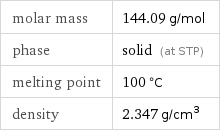Input interpretation

potassium selenocyanate
Chemical names and formulas

formula | KSeCN Hill formula | CKNSe name | potassium selenocyanate IUPAC name | selenocyanatopotassium alternate names | potassium selenoisocyanate | selenocyanatopotassium | selenocyanic acid | selenocyanic acid, potassium salt mass fractions | C (carbon) 8.34% | K (potassium) 27.1% | N (nitrogen) 9.72% | Se (selenium) 54.8%
Lewis structure

Draw the Lewis structure of potassium selenocyanate. Start by drawing the overall structure of the molecule, ignoring potential double and triple bonds: Count the total valence electrons of the carbon (n_C, val = 4), potassium (n_K, val = 1), nitrogen (n_N, val = 5), and selenium (n_Se, val = 6) atoms: n_C, val + n_K, val + n_N, val + n_Se, val = 16 Calculate the number of electrons needed to completely fill the valence shells for carbon (n_C, full = 8), potassium (n_K, full = 2), nitrogen (n_N, full = 8), and selenium (n_Se, full = 8): n_C, full + n_K, full + n_N, full + n_Se, full = 26 Subtracting these two numbers shows that 26 - 16 = 10 bonding electrons are needed. Each bond has two electrons, so in addition to the 3 bonds already present in the diagram add 2 bonds. To minimize formal charge nitrogen wants 3 bonds and carbon wants 4 bonds. Identify the atoms that want additional bonds and the number of electrons remaining on each atom: Fill in the 2 bonds by pairing electrons between adjacent highlighted atoms: Answer: | |
Basic properties

molar mass | 144.09 g/mol phase | solid (at STP) melting point | 100 °C density | 2.347 g/cm^3
Units

Solid properties (at STP)

density | 2.347 g/cm^3
Units

Chemical identifiers
![CAS number | 3425-46-5 Beilstein number | 3912121 PubChem CID number | 4178000 PubChem SID number | 24852939 SMILES identifier | C(#N)[Se][K] InChI identifier | InChI=1/CHNSe.K/c2-1-3;/h3H;/q;+1/p-1/fCNSe.K/h3h;/q-1;m/rCKNSe/c2-4-1-3 RTECS number | VT1400000 MDL number | MFCD00011366](../image_source/a4b7ca2284e8a6849835a27b7d30c121.png)
CAS number | 3425-46-5 Beilstein number | 3912121 PubChem CID number | 4178000 PubChem SID number | 24852939 SMILES identifier | C(#N)[Se][K] InChI identifier | InChI=1/CHNSe.K/c2-1-3;/h3H;/q;+1/p-1/fCNSe.K/h3h;/q-1;m/rCKNSe/c2-4-1-3 RTECS number | VT1400000 MDL number | MFCD00011366
Toxicity properties

RTECS classes | agricultural chemical and pesticide